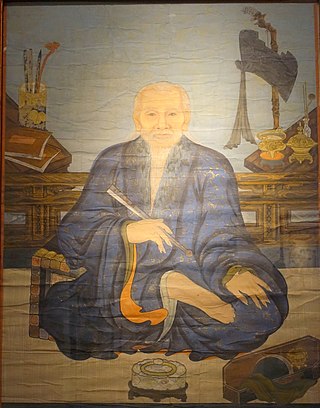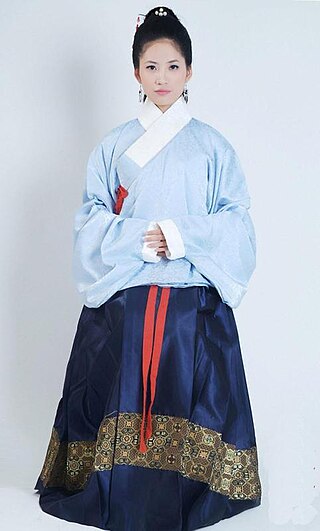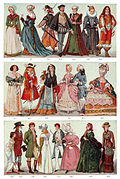
The hanbok is a traditional clothing of the Korean people. The term hanbok is primarily used by South Koreans; North Koreans refer to the clothes as chosŏn-ot (조선옷).

A queue or cue is a hairstyle worn by the Jurchen and Manchu peoples of Manchuria, and was later required to be worn by male subjects of Qing China. Hair on top of the scalp is grown long and is often braided, while the front portion of the head is shaved. The distinctive hairstyle led to its wearers being targeted during anti-Chinese riots in Australia and the United States.

Vietnamese clothing or Việt phục is the traditional style of clothing worn in Vietnam by the Vietnamese people. The traditional style has both indigenous and foreign elements due to the diverse cultural exchanges during the history of Vietnam. Due to it being part of the East Asian Cultural Sphere, Vietnamese traditional clothing have elements which bear similarities to those of China, Korea, and Japan. This all eventually led to the birth of a distinctive Vietnamese style of clothing, including the birth of the modern national dress of Vietnam, the áo dài.

Chinese clothing includes the traditional hanfu and garments of ethnic minorities, as well as modern variations of indigenous Chinese dresses. Chinese clothing has been shaped through its dynastic traditions, as well as through foreign influences. Chinese clothing showcases the traditional fashion sensibilities of Chinese culture traditions and forms one of the major cultural facets of Chinese civilization.

Gwanbok is a Korean term which was borrowed from the Chinese terms guanfu and guanfu. The term gwanbok is a collective term which refers to historical official attire, which was bestowed by the government court, including Chinese courts of various dynasties. The guanfu (冠服) system was a court attire system in China which also formed part of the Hanfu system. This system was them spread to neighbouring countries and was adopted in Korea since ancient times in different periods through the ritual practice of bestowal of clothing. Acknowledgement through bestowed robes and crowns (冠服) from the Emperor of China, who held hegemony over East Asia, would give support to Korean Kings and successors, as being the authentic rulers of their country as well as confirmed the political status of the Korean kingdom in the rest of the Sinosphere. The gwanbok system in Korea was different for each kingdom and changed throughout different periods. For example, initially given by the Chinese court in ritual practice, successive gwanbok were more often than not locally manufactured in Korea with different colours and adopted into hanbok. The gwanbok, which was used as the uniform of court officials, formed part of the gwanbok system and was used like the suit is nowadays.

Ruqun is a set of attire in Hanfu which consists of a short jacket typically called ru worn under a long Chinese skirt called qun. However, when use as a general term, ruqun can broadly describe a set of attire which consists of a separated upper garment and a wrap-around lower skirt, or yichang, in which yi means the "upper garment" and the chang means the "lower garment". In a broad sense, ruqun can include the shanqun and aoqun in its definition.
Banbi, also known as banxiu and sometimes referred as beizi or half-beizi before the term beizi eventually came to refer to a long-sleeved beizi in the Song dynasty, and referred as dahu in the Yuan dynasty, is an upper garment item in Hanfu. The banbi is in the form of a waistcoat or outerwear with short sleeves, which could either be worn over or under a long-sleeved ruqun. The style of its collar varies; it can also be secured at the front either with ties or a metal button.
A yuanlingshan is a type of round-collared upper garment in the traditional Chinese style of clothing known as Hanfu; it is also referred to as a yuanlingpao or a panlingpao when used as a robe. The yuanlingshan and yuanlingpao were both developed under the influence of ancient Chinese clothing, known as Hufu, originating from the Donghu people during the early Han dynasty and later by the Wuhu, including the Xianbei people, during the Six Dynasties period. The yuanlingpao is an article of formal attire primarily worn by men, although in certain dynasties, such as the Tang dynasty, it was also fashionable for women to wear. In the Tang dynasty, the yuanlingpao could be transformed into the fanlingpao using buttons.
Dragon robes, also known as gunlongpao or longpao for short, is a form of everyday clothing which had a Chinese dragon, called long (龍), as the main decoration; it was worn by the emperors of China. Dragon robes were also adopted by the rulers of neighbouring countries, such as Korea, Vietnam, and the Ryukyu Kingdom.

Hanfu are the traditional styles of clothing worn by the Han Chinese. There are several representative styles of hanfu, such as the ruqun, the aoqun, the beizi and the shenyi, and the shanku.

Mianfu is a kind of Chinese clothing in hanfu; it was worn by emperors, kings, and princes, and in some instances by the nobles in historical China from the Shang to the Ming dynasty. The mianfu is the highest level of formal dress worn by Chinese monarchs and the ruling families in special ceremonial events such as coronation, morning audience, ancestral rites, worship, new year's audience and other ceremonial activities. There were various forms of mianfu, and the mianfu also had its own system of attire called the mianfu system which was developed back in the Western Zhou dynasty. The mianfu was used by every dynasty from Zhou dynasty onward until the collapse of the Ming dynasty. The Twelve Ornaments were used on the traditional imperial robes in China, including on the mianfu. These Twelve Ornaments were later adopted in clothing of other ethnic groups; for examples, the Khitan and the Jurchen rulers adopted the Twelve ornaments in 946 AD and in 1140 AD respectively. The Korean kings have also adopted clothing embellished with nine out of the Twelve ornaments since 1065 AD after the Liao emperor had bestowed a nine-symbol robe to the Korean king, King Munjong, in 1043 AD where it became known as gujangbok.

Zaju chuishao fu, also called Guiyi, and sometimes referred as "Swallow-tailed Hems and Flying Ribbons clothing" or "swallow tail" clothing for short in English, is a form of set of attire in hanfu which was worn by Chinese women. The zaju chuishao fu can be traced back to the pre-Han period and appears to have originated the sandi of the Zhou dynasty; it then became popular during the Han, Cao Wei, Jin and Northern and Southern dynasties. It was a common form of aristocratic costumes in the Han and Wei dynasties and was also a style of formal attire for elite women. The zaju chuishao fu can be further divided into two categories of clothing style based on its cut and construction: the guipao, and the guichang.

Qixiong ruqun, which can also be referred as Qixiong shanqun, also known as "chest-high ruqun", is a set of attire in hanfu, the traditional Chinese clothing worn by the Han Chinese. The qixiong ruqun is a unique style of ruqun, which is characterized with a high waistline qun, Chinese skirt. The qun used in the qixiong ruqun is generally tied above the bust level. It was worn by women during the Southern dynasties, Sui dynasty, Tang dynasty and Five Dynasties and Ten Kingdoms period. The style was also revived in the early and middle Ming dynasty.

The founder of the Western Xia dynasty of China (1038–1227), Li Yuanhao, established an apparel system for all civil and military officials characterized by Tangut culture. Han-style and Tangut-style clothing were distinguished from each other, but both were used in the Western Xia. The Emperor Jingzong also ordered that all subjects of the Western Xia must be shaved in an attempt to restore old Xianbei customs, and disobedience would result in death penalty.
The fashion in the Yuan dynasty of Mongol (1271–1368) showed cultural diversity with the coexistence of various ethnic clothing, such as Mongol clothing, Han clothing and Korean clothing. The Mongol dress was the clothing of elite for both genders. Mongol attire worn in the 13th-14th century was different from the Han clothing from the Tang and Song dynasties. The Yuan dynasty court clothing also allowed the mixed of Mongol and Han style, and the official dress code of the Yuan dynasty also became a mixture of Han and Mongol clothing styles. After the founding of the Yuan dynasty, the Mongols strongly influenced the lifestyle and customs of the Han people.

Hufu, also referred as Hu clothing, nomadic dress, 'barbarian' clothing or dress, or foreign dress, is a generic term which refers to any clothing which was worn in ancient China and its surrounding regions by non-Han Chinese people. This term is also used to refer to foreigner's dress or clothing of foreign origins in ancient China. The introduction of Hufu-style garments and attire in China occurred by the time of King Wuling of Zhao.

Ru, sometimes referred as shan, ao, and yi, is a form of traditional Chinese upper garment, or coat, or jacket, which typically has a right closure; however, some of them can also have a front central opening. It is a daily upper garment for women of the Han Chinese ethnic. It can be worn in combination with a skirt in a style called ruqun, or a pair of trousers in a style called shanku.

Qizhuang, also known as Manfu and commonly inappropriately referred as Manchu clothing in English, is the traditional clothing of the Manchu people. Qizhuang in the broad sense refers to the clothing system of the Manchu people, which includes their whole system of attire used for different occasions with varying degrees of formality. The term qizhuang can also be used to refer to a type of informal dress worn by Manchu women known as chenyi, which is a one-piece long robe with no slits on either sides. In the Manchu tradition, the outerwear of both men and women includes a full-length robe with a jacket or a vest while short coats and trousers are worn as inner garments.

Tanling ruqun, also known as Tan collar ruqun and U-collar ruqun, is a type of Hanfu which was developed under the influence of Hufu ; it is a form a kind of ruqun which typically consists of three parts, featuring a low-cut low-cut U-shaped collar upper inner garment with long sleeves, a U-shaped collar banbi upper outer garment with short sleeves, a long high-waisted skirt. It can also be adorned with a shawl, called pipo. It was a popular form of clothing attire in the Sui and Tang dynasty. In the 21st century, the Tanling ruqun re-appeared as a result of the Hanfu movement. The 21st century Tanling ruqun was developed by reproducing the original patterns of the historical tanling ruqun while being aligned with modern aesthetics.
After the Jin dynasty was founded, the Jin dynasty rulers imitated the Song dynasty and decided to establish their own carriages and apparel system.










































